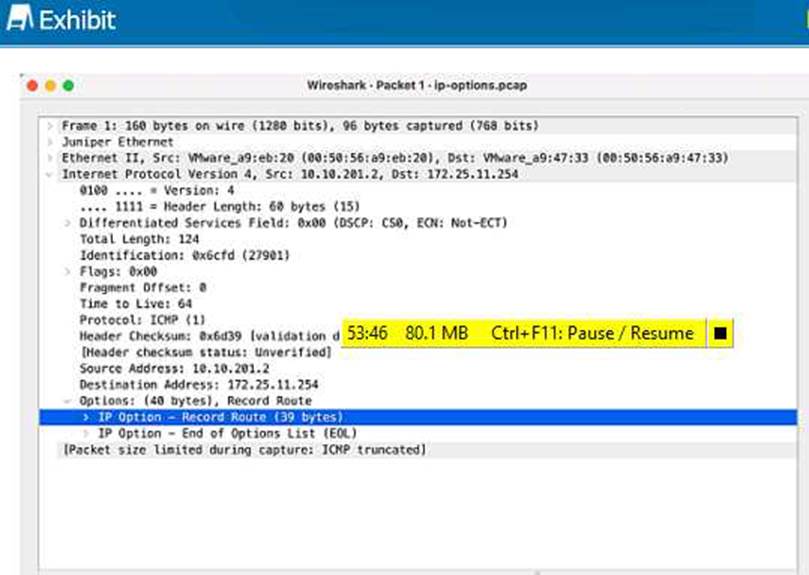Juniper JN0-104 Junos, Associate (JNCIA-Junos) Online Training
Juniper JN0-104 Online Training
The questions for JN0-104 were last updated at Apr 21,2025.
- Exam Code: JN0-104
- Exam Name: Junos, Associate (JNCIA-Junos)
- Certification Provider: Juniper
- Latest update: Apr 21,2025
You enable unicast reverse path forwarding on the ge-0/0/1.0 interface A packet is received on the ge-0/0/1.0 interface with a source address of 10.10.10.10. A route lookup determines that the next hop for the 10.10.10.10 address is the ge-0/0/1.0 interface. In this scenario which action is performed?
- A . The packet is logged
- B . The packet is forwarded
- C . The packet is rejected
- D . The packet is discarded
B
Explanation:
https://www.juniper.net/documentation/us/en/software/junos/security-services/topics/topic-map/interfaces-configuring-unicast-rpf.html
Referring to the exhibit.

what happens when you issue the exit command at the [edit protocols ospf area 0.0.0.51 stub] hierarchy level?
- A . You move one level up to the [edit protocols ospf area 0.0.0.51] hierarchy level.
- B . You exit the configuration mode.
- C . You move to the [edit] hierarchy level.
- D . You move to the most recent higher level of the [edit protocols ospf] hierarchy.
Exhibit:
[edit routing-options]
user@router# show
static {
route 0.0.0.0/0 {
next-hop 10.1.1.1;
qualified-next-hop 10.1.1.254 {
preference 4;
}
}
}
Assuming both paths shown in the exhibit are available, which statement is correct?
- A . Traffic matching the default route will use 172.16.1.1 as the next hop
- B . Traffic matching the default route will use 172.16.1.254 as the next hop
- C . Traffic matching the default route will be load-balanced per flow across both next hops
- D . Traffic matching the default route will be load-balanced per packet across both next hops.
Which attribute must be defined when configunng a non-root user in Junos OS?
- A . class
- B . uid
- C . authentication
- D . full-name
A
Explanation:
UID is optional (it is automatically set) whereas class is required: https://www.juniper.net/documentation/us/en/software/junos/user-access/topics/topic-map/junos-os-user-accounts.html
Your Junos OS routers use a static route to provide connectivity to the management network. You do not want this static route to be redistributed using a dynamic routing protocol.
In this scenario, which static route configuration parameter will accomplish this task?
- A . no-install
- B . no-retain
- C . no-resolve
- D . no-readvertise
Click the Exhibit button.

The user root is unable to connect to the router using SSH.
Referring to the exhibit, which configuration change will correct the problem?
- A . [edit]
user@router# set system services ssh root-login allow - B . [edit]
userr@outer# set system services ssh - C . [edit]
user@router# delete system services ssh - D . [edit]
use^@router# delete system services ssh root-login deny
A
Explanation:
https://www.juniper.net/documentation/us/en/software/junos/user-access/topics/ref/statement/ssh-edit-system.html
After logging in as root, you enter the cl i command.
What does this command do?
- A . It enables you to enter configuration mode.
- B . It enables you to enter line edit mode.
- C . It enables you to enter operational mode.
- D . It enables you to enter interface mode.
Click the Exhibit button.

Referring to the exhibit, which two statements are true? (Choose two.)
- A . The logical interface is running IPv6.
- B . The interface is operating in full-duplex mode.
- C . The address 172.25.11.255 is the broadcast address for the logical interface.
- D . The interface MAC address has been changed from the default MAC address.
Click the Exhibit button.

Click the Exhibit button.
What happens if the packet shown in the exhibit is received by a device running Junos OS?
- A . The packet is received by the RE first and then redirected to the PFE.
- B . The packet is received by the PFE first and then redirected to the RE.
- C . The packet is handled by the PFE alone.
- D . The packet is handled by the RE alone.
B
Explanation:
IP options are exception traffic
Packets addressed to the chassis, such as routing protocol updates, Telnet sessions, pings, traceroutes, and replies to traffic sourced from the RE;
• IP packets with the IP options field (options in the packet’s IP header are rarely seen, but the PFE was purposely designed not to handle IP options; packets with IP options must be sent to the RE for processing); and
• Traffic that requires the generation of Internet Control Message Protocol (ICMP) messages.
Click the Exhibit button.

Click the Exhibit button.
Referring to the exhibit, which statement is correct about traffic received on the ge-0/0/1.0 interface?
- A . All traffic will be silently dropped.
- B . All traffic will be accepted.
- C . All traffic will be dropped and a UDP message sent back to the source.
- D . All traffic will be dropped and an ICMP notification sent back to the source.
Latest JN0-104 Dumps Valid Version with 139 Q&As
Latest And Valid Q&A | Instant Download | Once Fail, Full Refund

